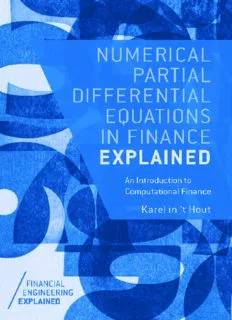Table Of ContentFinancial Engineering Explained
Series Editor
Wim Schoutens
Department of Mathematics
Katholieke Universiteit Leuven
Heverlee, Belgium
Financial Engineering Explained is a series of concise, practical guides
tomodernfinance,focusingonkey,technicalareasofriskmanagement
and asset pricing. Written for practitioners, researchers and students,
the series discusses a range of topics in a non-mathematical but highly
intuitiveway.Eachself-containedvolumeisdedicatedtoaspecifictopic
and offers a thorough introduction with all the necessary depth, but
without too much technical ballast. Where applicable, theory is illus-
tratedwithrealworldexamples,withspecialattentiontothenumerical
implementation.
More information about this series at
http://www.springer.com/series/14984
Karelin’tHout
Numerical Partial
Differential Equations
in Finance Explained
An Introduction to Computational Finance
Karelin’tHout
DepartmentofMathematicsand
ComputerScience
UniversityofAntwerp
Antwerp
Belgium
FinancialEngineeringExplained
ISBN978-1-137-43568-2 ISBN978-1-137-43569-9(eBook)
DOI10.1057/978-1-137-43569-9
LibraryofCongressControlNumber:2017934655
©TheEditor(s)(ifapplicable)andTheAuthor(s)2017
The author(s) has/have asserted their right(s) to be identified as the author(s) of this work in
accordancewiththeCopyright,DesignsandPatentsAct1988.
This work is subject to copyright. All rights are solely and exclusively licensed by the Publisher,
whether the whole or part of the material is concerned, specifically the rights of translation,
reprinting,reuseofillustrations,recitation,broadcasting,reproductiononmicrofilmsorinanyother
physicalway,andtransmissionorinformationstorageandretrieval,electronicadaptation,computer
software,orbysimilarordissimilarmethodologynowknownorhereafterdeveloped.
Theuseofgeneraldescriptivenames,registerednames,trademarks,servicemarks,etc.inthispub-
licationdoesnotimply,evenintheabsenceofaspecificstatement,thatsuchnamesareexemptfrom
therelevantprotectivelawsandregulationsandthereforefreeforgeneraluse.
Thepublisher,theauthorsandtheeditorsaresafetoassumethattheadviceandinformationinthis
bookarebelievedtobetrueandaccurateatthedateofpublication.Neitherthepublishernorthe
authorsortheeditorsgiveawarranty,expressorimplied,withrespecttothematerialcontained
hereinorforanyerrorsoromissionsthatmayhavebeenmade.Thepublisherremainsneutralwith
regardtojurisdictionalclaimsinpublishedmapsandinstitutionalaffiliations.
Printedonacid-freepaper
ThisPalgraveMacmillanimprintispublishedbySpringerNature
TheregisteredcompanyisMacmillanPublishersLtd.
Theregisteredcompanyaddressis:TheCampus,4CrinanStreet,London,N19XW,UnitedKingdom
Preface
A few years after Black and Scholes [5] derived their famous par-
tial differential equation (PDE) for the fair values of European call
and put options, Schwartz [78] considered a finite difference discret-
ization for its approximate solution. Today, the numerical solution
of time-dependent PDEs forms one of the pillars of computational
finance. Efficient, accurate and stable numerical methods are imper-
ative for financial institutions and companies worldwide. Extensive
researchisperformed,bothinacademiaandindustry,intotheirdevel-
opment, analysis and application. This book is intended as a concise,
gentle introduction into this interesting and dynamic field. Its aim is
to provide students and practitioners with an easily accessible, prac-
ticaltextexplainingmainconcepts,models,methodsandresults.The
text is organized through a sequence of short chapters. The style is
moredescriptivethan(mathematically)rigorous.Numerousexamples
and numerical experiments are given to illustrate results. Only some
elementary knowledge of mathematics, notably calculus and linear
algebra, is assumed.
The numerical solution processes in this book are obtained fol-
lowing the popular method of lines (MOL) approach. Here a given
time-dependent PDE is semidiscretized on a grid by finite difference
formulas, which yields a large system of ordinary differential equa-
tions (ODEs). Subsequently, a suitable temporal discretization method
is applied, which defines the full discretization.
Chapters1and2introducefinancialoptionvaluationandpartialdif-
ferentialequations.Next,theMOLapproachiselaboratedinChapters
3–8. Much attention is paid to studying stability and convergence of
v
vi Preface
the various discretizations. Important special topics, such as bound-
ary conditions, nonuniform grids, the treatment of nonsmooth initial
data and approximation of the so-called Greeks, are included in the
discussion. In this part the Black–Scholes PDE serves as the prototype
equation for the numerical experiments. Examining numerical meth-
odsintheirapplicationtothisequationprovideskeyinsightintotheir
properties and performance when applied to many advanced PDEs in
contemporary financial mathematics.
After having considered European call and put options as an ex-
ample, we move on to explore the numerical valuation of more
challenging modern types of options: cash-or-nothing options in
Chapter 9, barrier options in Chapter 10 and American options in
Chapter 11. The latter type of options leads to partial differential in-
equalities and an additional step in the numerical solution process is
required,whereso-calledlinearcomplementarityproblemsaresolved.
Chapter 12 is devoted to option valuation in the presence of jumps
in the underlying asset price evolution. This gives rise to partial
integro-differential equations. These equations can be viewed as PDEs
with an extra integral term. For their effective numerical solution,
operator splitting methods of the implicit-explicit (IMEX) kind are
introduced.
Chapter 13 extends the MOL approach to two-dimensional PDEs in
finance.SemidiscretizationthenresultsinverylargesystemsofODEs.
For the efficient temporal discretization, operator splitting methods
of the Alternating Direction Implicit (ADI) kind are discussed. As an
example, the numerical valuation of a two-asset option under the
Black–Scholes framework is considered.
Mostofthechaptersconcludewithashortsectionwherenotesand
referencestotheliteraturearegiven.Theseareintendedaspointersto
readers who wish to broaden their knowledge or deepen their under-
standingofthetopicsunderconsideration.Supplementarymaterialto
this book will be provided on my website.
I am grateful to Peter Forsyth, Sven Foulon, Willem Hundsdorfer,
Wim Schoutens, Jari Toivanen and Maarten Wyns for their genuine
interest and their valuable suggestions and comments on prelimin-
ary versions of this book. Last but not least, I wish to thank Palgrave
Macmillan for the pleasant cooperation.
Antwerp, July 2016 Karel in ’t Hout
Contents
1 FinancialOptionValuation........................................................ 1
1.1 FinancialOptions................................................................ 1
1.2 TheBlack–ScholesPDE ......................................................... 3
2 PartialDifferentialEquations.................................................... 9
2.1 Convection-Diffusion-ReactionEquations...................................... 9
2.2 TheModelEquation............................................................. 10
2.3 BoundaryConditions............................................................ 12
2.4 NotesandReferences ........................................................... 14
3 SpatialDiscretizationI............................................................. 15
3.1 MethodofLines.................................................................. 15
3.2 FiniteDifferenceFormulas...................................................... 17
3.3 Stability........................................................................... 21
3.4 NotesandReferences ........................................................... 23
4 SpatialDiscretizationII............................................................ 25
4.1 BoundaryConditions............................................................ 25
4.2 NonuniformGrids............................................................... 29
4.3 NonsmoothInitialData.......................................................... 32
4.4 MixedCentral/UpwindDiscretization.......................................... 33
4.5 NotesandReferences ........................................................... 35
5 NumericalStudy:Space............................................................ 37
5.1 CellAveraging.................................................................... 38
5.2 NonuniformGrids............................................................... 41
5.3 BoundaryConditions............................................................ 42
vii
viii Contents
6 TheGreeks............................................................................. 45
6.1 TheGreeks....................................................................... 45
6.2 NumericalStudy................................................................. 47
6.3 NotesandReferences ........................................................... 50
7 TemporalDiscretization........................................................... 51
7.1 Theθ-Methods................................................................... 51
7.2 StabilityandConvergence....................................................... 52
7.3 MaximumNormandPositivity.................................................. 58
7.4 NotesandReferences ........................................................... 60
8 NumericalStudy:Time............................................................. 61
8.1 ExplicitMethod.................................................................. 61
8.2 ImplicitMethods................................................................. 63
8.3 NotesandReferences ........................................................... 68
9 Cash-or-NothingOptions.......................................................... 69
10 BarrierOptions....................................................................... 75
11 American-StyleOptions............................................................ 81
11.1 American-StyleOptions......................................................... 81
11.2 LCPSolutionMethods........................................................... 84
11.3 NumericalStudy................................................................. 86
11.4 NotesandReferences ........................................................... 90
12 MertonModel......................................................................... 91
12.1 MertonModel.................................................................... 91
12.2 SpatialDiscretization............................................................ 93
12.3 IMEXSchemes................................................................... 95
12.4 NumericalStudy................................................................. 96
12.5 NotesandReferences ........................................................... 97
13 Two-AssetOptions................................................................... 99
13.1 Two-AssetOptions............................................................... 99
13.2 SpatialDiscretization............................................................ 101
13.3 ADISchemes..................................................................... 106
13.4 NumericalStudy................................................................. 108
13.5 NotesandReferences ........................................................... 111
AppendixA:WienerProcess........................................................... 113
AppendixB:Feynman–KacTheorem............................................... 115
AppendixC:Down-and-OutPutOptionValue.................................... 117
Contents ix
AppendixD:Max-of-Two-AssetsCallOptionValue ............................. 119
Bibliography................................................................................ 121
Index .......................................................................................... 127
Description:This book provides a first, basic introduction into the valuation of financial options via the numerical solution of partial differential equations (PDEs). It provides readers with an easily accessible text explaining main concepts, models, methods and results that arise in this approach. In keeping

